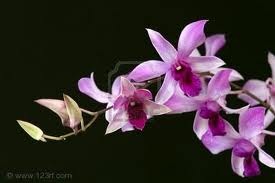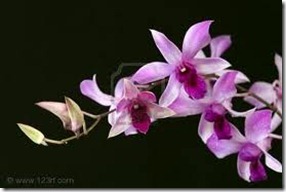-
The best way to treat dendrobium orchid diseases is to prevent them. Proper watering, temperature control and air circulation will go a long way toward preventing these maladies. Use a good orchid growing medium that drains quickly. Fir tree bark or coconut chips work well for dendrobiums. Wash your hands before handling the plants, always sterilize knives and pruning implements and keep the area around the orchids clean.
Basal Rot
-
Basal rot, or southern blight, is caused by excessive watering or inefficient drying combined with cool, humid conditions. It starts at the bottom of the plant and works its way up. If only a small part of the plant is affected, the diseased area can be cut away with a sharp knife and the clean edges treated with sulfur. Reduce watering and make sure the plant dries quickly after watering until it heals.
Botrytis
-
Botrytis is a fungal disease that attacks the flowers. It is facilitated by cool, moist conditions and insufficient air circulation. Tiny black spots appear on the flower petals and develop into a gray fuzzy mold. To treat this condition, increase night temperatures to 65 degrees Fahrenheit or higher and increase the air circulation. Clear away infected dead blooms that have fallen off the plant and treat the floor and surface areas with a strong fungicide. Spray the infected plant and other nearby plants with a mild liquid fungicide.
Fusarium Wilt
-
Fusarium wilt is characterized by shriveled, dried-out leaves and a gray appearance to the whole plant. The cause is lack of water, either from insufficient watering or over-watering that has caused the roots to rot. If there are live roots on the orchid, re-pot it in fresh, moist orchid seedling mix. Place it in a less well-lit location, keep it slightly moist (but not soaking wet) and mist it once or twice each day. The plant may not start growing again until the next season.
Pseudomonas Cattleyae
-
Pseudomonas cattleyae, or brown wet spot, is a bacterial infection. It is characterized by brownish-black soft areas that normally appear on the underside of the leaves and quickly work their way through to the top. This is an aggressive infection that can destroy a plant within a few days. The cause is poor air movement, cool temperatures and high humidity. Nighttime temperatures between 60 and 65 degrees Fahrenheit and good air circulation will prevent this problem. If the crown of the plant is affected, it can’t be saved. If the infection has not reached the crown, lance, cut or scrape away the damaged plant tissue and dust the surface with sulfur or powdered fungicide. Keep the orchid away from other orchids until it has fully recovered.
Orchid Virus
-
Orchid virus kills leaf cells, opening up the plant to bacterial infection. This disease is not detectable in its early stages. Advanced orchid virus is indicated by black rings and round or diamond-shaped spots. There is no cure for orchid virus and it is easily spread from plant to plant by insects and cutting tools.


Deprecated: strpos(): Passing null to parameter #1 ($haystack) of type string is deprecated in /home/agriviek8Qv/agriviet.net/public_html/wp-includes/comment-template.php on line 2522